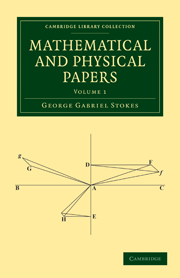Book contents
- Frontmatter
- PREFACE
- Contents
- On the Steady Motion of Incompressible Fluids
- On some cases of Fluid Motion
- On the Motion of a Piston and of the Air in a Cylinder
- On the Theories of the Internal Friction of Fluids in Motion, and of the Equilibrium and Motion of Elastic Solids
- On the Proof of the Proposition that (Mx + Ny)-1 is an Integrating Factor of the Homogeneous Differential Equation M+N dy/dx = 0
- On the Aberration of Light
- On Fresnel's Theory of the Aberration of Light
- On a Formula for determining the Optical Constants of Doubly Refracting Crystals
- On the Constitution of the Luminiferous Ether, viewed with reference to the Aberration of Light
- Report on Recent Researches on Hydrodynamics
- Supplement to a Memoir on some cases of Fluid Motion
- On the Theory of Oscillatory Waves
- On the Resistance of a Fluid to two Oscillating Spheres
- On the Critical Values of the Sums of Periodic Series
- Supplement to a paper on the Theory of Oscillatory Waves
- Index
On the Resistance of a Fluid to two Oscillating Spheres
Published online by Cambridge University Press: 07 September 2010
- Frontmatter
- PREFACE
- Contents
- On the Steady Motion of Incompressible Fluids
- On some cases of Fluid Motion
- On the Motion of a Piston and of the Air in a Cylinder
- On the Theories of the Internal Friction of Fluids in Motion, and of the Equilibrium and Motion of Elastic Solids
- On the Proof of the Proposition that (Mx + Ny)-1 is an Integrating Factor of the Homogeneous Differential Equation M+N dy/dx = 0
- On the Aberration of Light
- On Fresnel's Theory of the Aberration of Light
- On a Formula for determining the Optical Constants of Doubly Refracting Crystals
- On the Constitution of the Luminiferous Ether, viewed with reference to the Aberration of Light
- Report on Recent Researches on Hydrodynamics
- Supplement to a Memoir on some cases of Fluid Motion
- On the Theory of Oscillatory Waves
- On the Resistance of a Fluid to two Oscillating Spheres
- On the Critical Values of the Sums of Periodic Series
- Supplement to a paper on the Theory of Oscillatory Waves
- Index
Summary
The object of this communication was to shew the application of Professor Thomson's method of images to the solution of certain problems in hydrodynamics. Suppose that there exists in an infinite mass of incompressible fluid a point from which, or to which the fluid is flowing with a velocity alike in all directions. Conceive now two such points, of intensities equal in magnitude and opposite in sign, to coexist in the fluid; and then suppose these points to approach, and ultimately coalesce, their intensities varying inversely as the distance between them. Let the resulting point be called a singular point of the second order. The motion of a fluid about a solid, oscillating sphere is the same as if the solid sphere were replaced by fluid, in the centre of which existed such a point. It is easy to shew that the motion of the fluid due to a point of this kind, when the fluid is interrupted by a sphere having its centre in the axis of the singular point, is the same as if the sphere's place were occupied by fluid containing one singular point of the second order. By the application of this principle may be found the resistance experienced by a sphere oscillating in presence of a fixed sphere or plane, or within a spherical envelope, the oscillation taking place in the line joining the centres, or perpendicular to the plane.
- Type
- Chapter
- Information
- Mathematical and Physical Papers , pp. 230 - 235Publisher: Cambridge University PressPrint publication year: 2009First published in: 1880



